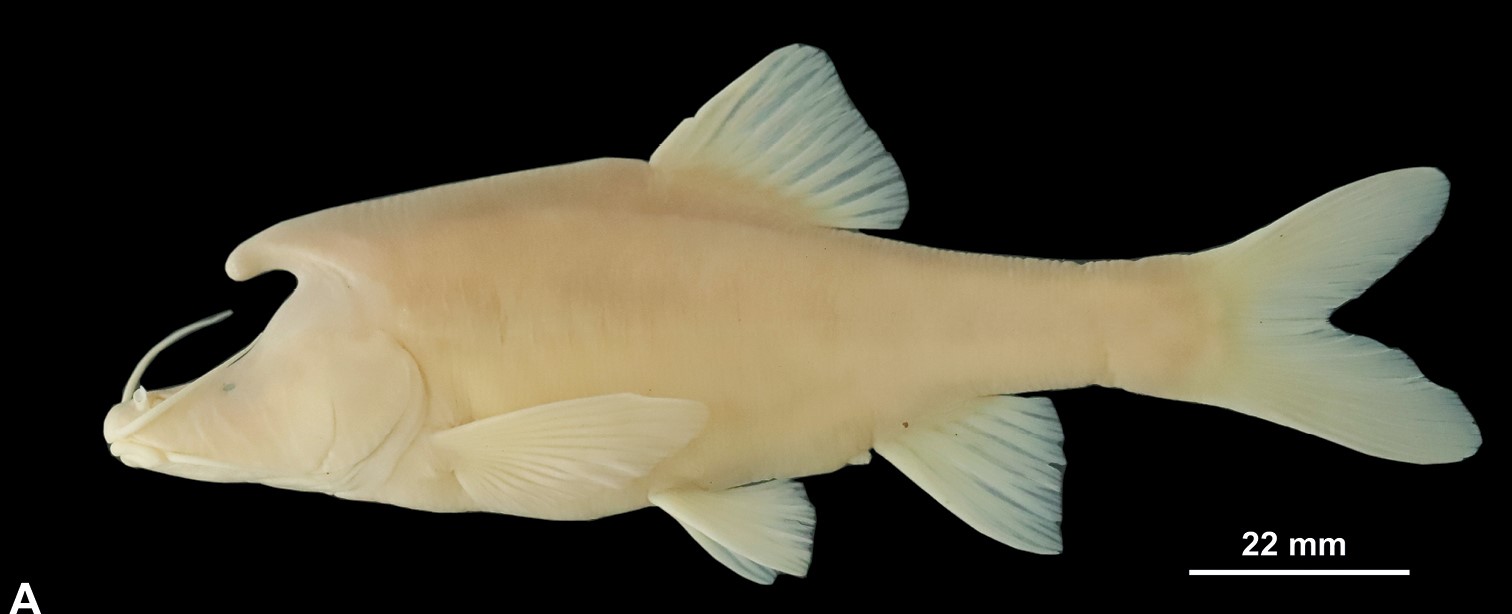Unicorn-like blind fish discovered in dark waters deep in Chinese cave
Researchers stumbled across a bizarre species of blind cave fish with a mysterious, horn-like structure protruding from its head and a lack of scales or pigmentation.
Lurking within the dark waters of Chinese caves is a bizarre fish species that has an uncanny resemblance with mythical equine creature. The newfound fish weirdos, which researchers discovered hiding in a pitch-black pool the size of a kitchen table, have no scales or color, tiny rudimentary eyes that likely cannot see anything and an unusually large horn jutting out of their foreheads, a new study reveals.
The researchers found the drab, unicorn-like fish while surveying cave fish from the genus Sinocyclocheilus. Fish in this genus are found only in China, usually within small pools that are shrouded in darkness. There are 76 known species of Sinocyclocheilus, most of which share similar characteristics with the newfound species, such as reduced or no vision, a lack of scales and no pigmentation. However, only some Sinocyclocheilus fish possess a horn, and others have lost their eyes completely in a process known as regressive evolution, in which species lose complex features over generations. There are also a handful of Sinocyclocheilus species that live in illuminated waters and lack the unusual features associated with their freaky cousins.
Researchers discovered the newfound fish swimming in a small pool measuring 5.9 feet (1.8 meters) wide and 2.6 feet (0.8 m) deep, inside a cave in the mountainous Guizhou province. The team collected individuals to take back to the lab and examine, unaware that they were collecting a never-before-seen species. After comparing the fish with other known species and analyzing their DNA, the researchers realized what they had uncovered.
In the new study, published Jan. 17 in the journal ZooKeys, the team described the species, which they named S. longicornus. The fish are between 4.1 and 5.7 inches (10.5 to 14.6 centimeters) long and possess two pairs of whisker-like barbels that they use to feel their way around in the dark. But perhaps their most interesting feature is their unusually long horn-like structure, which has no clear use, and isn't found in closely related species. (The name longicornus is derived from the Latin words longus, meaning "long," and cornu, meaning "horn of the forehead.")
Related: Scientists discover beautiful new rainbow-colored fish lurking among 'twilight reefs'
These horn-like strucutres differ widely among dark-dwelling Sinocyclocheilus species; they vary in length and can either be forked or non-forked, like in S. longicornus. As light-dwelling species do not have horns, these appendages likely have something to do with living in the dark, but it is not clear what their purpose is, the researchers wrote in the paper.
The most logical explanation would be that the horns help these fish to "see" in the dark, but their barbels already enable them to navigate around their pool, which is not very big so would likely require minimal navigation skills anyway. Most Sinocyclocheilus species, including S. longicornus, also have a fully formed lateral line — an organ made up of highly sensitive cells that runs laterally down a fish's body and detects changes in pressure, temperature and salinity — so the horn is also unlikely to be needed to detect those.
Get the world’s most fascinating discoveries delivered straight to your inbox.
However, the unusual size of the horn on S. longicornus, coupled with the fact the new species is not closely related to other long-horned species, suggests that longhorns have emerged on at least two separate occasions in the genus, researchers wrote. Therefore, comparing the environmental conditions of S. longicornus with some of the other long-horned species could finally reveal what the mysterious structures are actually used for.

Harry is a U.K.-based senior staff writer at Live Science. He studied marine biology at the University of Exeter before training to become a journalist. He covers a wide range of topics including space exploration, planetary science, space weather, climate change, animal behavior and paleontology. His recent work on the solar maximum won "best space submission" at the 2024 Aerospace Media Awards and was shortlisted in the "top scoop" category at the NCTJ Awards for Excellence in 2023. He also writes Live Science's weekly Earth from space series.




